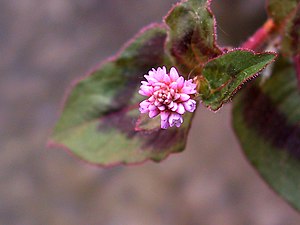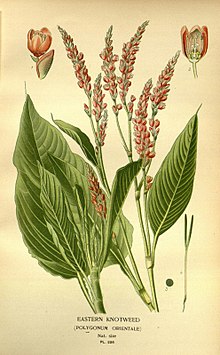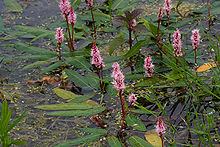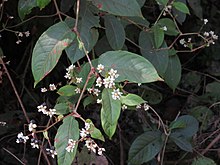Knotweed
| Knotweed | ||||||||||||
|---|---|---|---|---|---|---|---|---|---|---|---|---|

|
||||||||||||
| Systematics | ||||||||||||
|
||||||||||||
| Scientific name | ||||||||||||
| Persicaria | ||||||||||||
| Mill. |
The knot oaks ( Persicaria ) are a genus of plants within the knotweed family (Polygonaceae). The approximately 100 species are common in the temperate latitudes of the northern hemisphere .
description

Vegetative characteristics
The Persicaria species grow as annual, more rarely perennial herbaceous plants . The independently upright to prostrate stems are herbaceous, sometimes woody. The alternate leaves can be stalked or sessile. The simple leaf blades are narrow, linear-lanceolate to elliptical-ovate. The leaf margins are usually smooth, rarely lobed. Usually they have no glands, only rarely are they dotted with glands. The Tuten ( Ochreae ) are tubular, membranous, lashed at the opening, less often not lashed.
Generative characteristics
The terminal or lateral, spiked , racemose or, less often, capitular inflorescences often contain many flowers. The Ochreolae (Tuten of the bracts) are tubular, membranous, ciliate to divided.
The flowers are hermaphroditic or functionally unisex. The Perianth consists of four to five bloom cladding sheets, which are mostly divided to about the middle. The nectar glands are alternating with the four to eight stamens . The stamens are free or fused at their base. The anthers are yellow, pink or red. Two to three carpels are a bi-convex to triangular ovary grown. The two to three long, thread-like styluses are fused or free; they each end with a heady scar .
The biconvex to triangular nuts are bare, shiny and dark brown to black.


Systematics and distribution
The genus Persicaria was established by Philip Miller . The generic name Persicaria is derived from the Latin word persica for peach and - aria for referring to, this refers to the similarity of the leaves of some Persicaria species.
The genus Persicaria used to be part of the genus Polygonum as section Persicaria , but is now mainly treated as an independent genus. In the narrower sense, it includes around 100 (to 150) species. Quite often the species of the genera Bistorta , Rubrivena , Aconogon and Knorringia are placed in the genus Persicaria . The description here and the list of species relate to the genus in the narrower sense.
The genus Persicaria belongs to the tribe Persicarieae in the subfamily Polygonoideae within the family Polygonaceae .
The Persicaria species occur in the temperate latitudes of the northern hemisphere . Here is a selection:
- Water knotweed ( Persicaria amphibia (L.) Delarbre )
- Persicaria barbata (L.) H. Hara (Syn .: Polygonum barbatum L. ): It is common in Asia and New Guinea.
- Persicaria bungeana (Turcz.) Nakai (Syn .: Polygonum bungeanum Turcz. ): It is native to East Asia and a neophyte in North America.
- Head knotweed ( Persicaria capitata (Buch.-Ham. Ex D.Don) H.Gross , Syn .: Polygonum capitatum Buch.-Ham. Ex D.Don ): It originally occurs in tropical Asia and China and is found in Central Europe rarely overgrown.
- Persicaria careyi (Olney) Greene (Syn .: Polygonum careyi Olney ): It is common in North America.
- Persicaria chinensis (L.) H. Gross (Syn .: Polygonum chinense L. ): It is widespread in Asia.
- Mild knotweed ( Persicaria dubia (stone) Fourr. , Syn .: Polygonum mite cabinet )
- Persicaria filiformis (Thunb.) Nakai (Syn .: Polygonum filiforme Thunb. ): It occurs in Japan.
- Water pepper ( Persicaria hydropiper (L.) Delarbre )
- Dock knotweed ( Persicaria lapathifolia (L.) Delarbre )
- Flea knotweed ( Persicaria maculosa Gray )
- Lesser knotweed ( Persicaria minor (Huds.) Opiz )
- Persicaria nepalensis (Meisn.) H. Gross (Syn .: Polygonum nepalense Meisn. ): It is native to Asia and a neophyte in North America, Europe and Africa.
- Oriental knotweed ( Persicaria orientalis (L.) Spach ): It is originally found in Asia and Australia, but is used as an ornamental plant in Central Europe and is occasionally found wild.
- Pennsylvanian knotweed ( Persicaria pensylvanica (L.) M.Gómez , Syn .: Polygonum pensylvanicum L. ): It is native to North America.
- Persicaria perfoliata (L.) H. Gross (Syn .: Polygonum perfoliatum L. ): It is native to Asia, New Guinea and a neophyte in North America.
- Persicaria posumbu (Buch.-Ham. Ex D.Don) H.Gross (Syn .: Polygonum posumbu Buch.-Ham. Ex D.Don ): It is widespread in Asia.
- Persicaria salarkhanii ( Hassan Md. Abul Hassan ) (Syn .: Ampelygona salarkhanii ): An endemic of eastern Bangladesh.
- Persicaria senegalensis (Meisn.) Soják (Syn .: Polygonum senegalensis Meisn. ): It is widespread in Africa.
- Dyer's knotweed ( Persicaria tinctoria (WTAiton) Spach , Syn .: Polygonum tinctorium W.T. Aiton) : It is widespread in Eastern Europe and Asia.
- Persicaria virginiana (L.) Gaertn. (Syn .: Polygonum virginianum L. ): It is common in North America and Mexico.
swell
- Harold R. Hinds, Craig C. Freeman: Persicaria - text same online as printed work , In: Flora of North America Editorial Committee (Ed.): Flora of North America North of Mexico , Volume 5 - Magnoliophyta: Caryophyllidae, part 2 , Oxford University Press, New York and Oxford, 2005. ISBN 0-19-522211-3 (Description and Common Name Sections)
- Mohammad Qaiser: Polygonaceae in the Flora of Pakistan , Volume 205, University of Karachi, Department of Botany, Missouri Botanical Press, Karachi and St. Louis, 2001: Persicaria at Tropicos.org. of the Missouri Botanical Garden. (Section description)
Individual evidence
- ↑ a b c d e Persicaria in the Germplasm Resources Information Network (GRIN), USDA , ARS , National Genetic Resources Program. National Germplasm Resources Laboratory, Beltsville, Maryland. Retrieved December 11, 2013.


